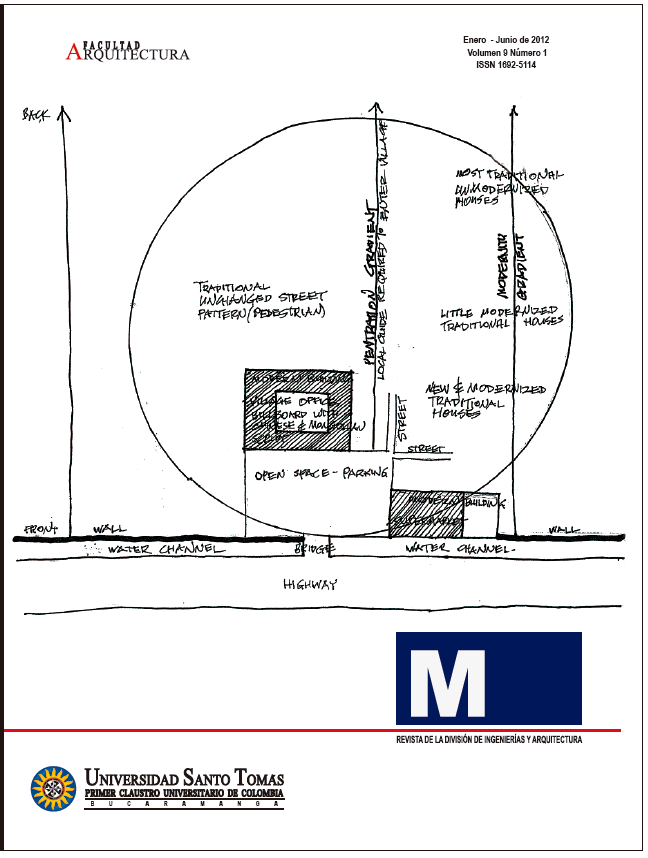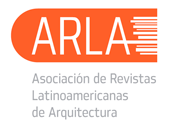EL PAPEL DE LA CONSTANCIA EN EL APRENDIZAJE DEL PASADO. EL RASTRO PERDIDO
Resumen
En este artículo vuelvo a visitar algunos de los temas que antes he abordado, hace mucho tiempo. Necesitan reiteración porque han sido re-examinados. El tema trata esencialmente sobre aprender del pasado y de la amplia gama de entornos que conocemos. Este es un recurso increíble, un registro de cómo el ser humano ha creado ambientes, patrones y sus éxitos y fracasos, entre otros. La suposición que uno puede aprender del pasado, que hay valor en la tradición, presupone alguna constancia de las personas y el entorno. Esto se discute brevemente y el punto alcanzado es que tal aprendizaje debe estar a cierto nivel de abstracción. El trabajo a ese nivel también abre muchos campos nuevos e inesperados (y “poco probables”), se torna importante involucrar nuevos campos y sus evoluciones en la investigación EBS (Environment-Behavior Studies). Un ejemplo reciente de este tipo de campos “poco probables” se discute brevemente.
ABSTRACT
In this paper I revisit some themes I have addressed before, some a very long time ago. They need reiterating because they are being re-examined. The topic is essentially about learning from the past and from the full range of environments about which we know. These are an incredible resource, a record of how human have created environments, their successes and failure, patterns, etc. The assumption that one can learn from the past, that there is value in tradition, presupposes some constancy regarding both people and environments. This is discussed briefly and the point made that such learning need to be at some level of abstraction. Working at that level also makes relevant many new and unexpected (and “unlikely”) fields, it then becomes important to involve new fields, and developments in them in EBS (Environment-Behavior Studies) research, one recent example of such on “unlikely” field is discussed briefly.
Referencias
APICELLA, C.L, et.al. “Social networks and cooperation in hunter-gatherers”. In Nature, Vol. 481, Issue 7382, January. 2012
ATRAM, S. In Gods we trust (The evolutionary landscape of religión). Oxford: Oxford University Press, 2002.
BACON, E.N. Design of cities. New York: Viking Press, 1967.
BARKOW, J.W., et.al. The adapted mind (evolutionary psychology and the generation of culture. New York: Oxford University Press, 1992.
BETZIG, L. (Ed.). Human nature:a critical reader. New York: Oxford University Press, 1997.
BROWN, D.E. Human Universals. Philadelphia: Temple University Press, 1991.
CARTWRIGHT, J. Evolution and human behavior. London: Palgrave, 2001.
CRONK, L. That complex whole (culture and the evolution of human behavior). Boulder CO:Westview Press, 1999.
DEARBORN, L.M., “Reconstituting among cultura and traditions in Milwaukee.
WISCONSIN”. In: Traditional dwellings and settlements review. Vol. 19, No. 2. Spring, 2008.
DUTTON, D. “The art instinct”. Beauty, pleasure and human evolution. New York: Bloomsbury Press, 2010.
EPSTEIN, J. “Toddling town”. In: Commentary. Vol. 128, No. 4. November. 2009.
ETZIONI, E. “Bottom-up nation building”. In: Policy Review. No 158. December. 2009.
GOLDSMITH, T.H., The biological roots of human Behavior. New York: Oxford University Press, 1991.
HAUSER, M.D. “The possibility of imposible cultures”. In Nature, Vol. 460, Issue 7252, July. 2009.
KONNER, M. The evolution of childhood. Cambridge, MA: Belknap Press of Harvard University, 2010.
McINTYRE, L. Dark ages (the case for a science of human behavior). Cambridge, MA.: Bradford Books/MIT Press, 2006.
MILLER, G. The mating mind. New York: Doubleday, 2000.
O´DONELL, S. Towards urban framework (accommodating change in urban cultural landscapes). Milwaukee, WI: Dept. of Architecture. M. Arch Thesis (unpublished)
PINKER, S. The blank slate (the modern denial of human nature). New York: Viking, 2002.
RAPOPORT, A. Human aspects of urban form,Oxford: Pergamon Press, 1977.
RAPOPORT, A. “Development, culture change and supportive design”. In: Habitat International. Vol. 7 No. 5/6. 1983.
RAPOPORT, A. “The use and design of open spaces in urban neighborhoods”. In: FRICK, D. (Ed.) The quality of urban life (social, psychological and physical conditions). Berlín: De Gruyter, 1986.
RAPOPORT, A. ”Learning about settlements and energy from historical precedents”. In: Ekistics.Vol. 54, Nos. 325-327 (July-Dec). 1987.
RAPOPORT, A. “Spontaneous settlements as vernacular design” in C.V. Patton (ed.) Spontaneus Shelter. Philadelphia, Temple University Press. 1988.
RAPOPORT, A. “On the attributes of tradition”. In J-P. Bourdier and N. Aesayyad (eds.) Dwellings, settlements and tradition, Lanham, M D. University Press of America. 1989.
RAPOPORT, A. “Defining vernacular DESIGN”. In: TURAN, M. (Ed.) Vernacular architecture (Paradigms of Environmental Response. Aldershot. (UK). Avebury. 1990a.
RAPOPORT, A. The meaning of the build environment. Tucson: University of Arizona Press, 1990b.
RAPOPORT, A. History and precedent in Environmental Design, New York. Plenum, 1990c.
RAPOPORT, A. “Levels of meaning and types of environments”. In Y. YOSHITAKE et.al. (Eds.) Current Issues in Environment-Behavior Research. Tokio, University of Tokio. 1990d.
RAPOPORT, A. ”Systems of activities and systems of settings”. In: KENT, S. (Ed.) Domestic architecture and the use of space. Cambridge: Cambridge University Press, 1990e.
RAPOPORT, A. ”Indirect approaches to environment-behavior research”. In: The National Geographical Journal of India. Vol. 36 (parts 1 and 2) March/June, 1990f.
RAPOPORT, A. “Pedestrian street use: culture and perception”. In: VERNEZ
MOUDON, A. (Ed.) Public streets for public use.New York: Columbia University Press, 1991.
RAPOPORT, A. “On cultural landscapes”. In: Traditional Dwellings and Settlements Review. Vol. 3, No 2. (Spring). 1992a.
RAPOPORT, A. “On regions and regionalism”. In: MARKOVICH, N.C., PREISER, W.F.E, and STURM, F.G. (Eds.) Pueblo style and regional architecture. New York: Van Nostrand Reinhold, 1992b. (paperback edition only).
RAPOPORT, A. Cross-cultural studies and urban form.(The 1992 Lefrak Lectures) College Park, MD, University of Maryland, Urban Studies and Planning Program. 1993a.
RAPOPORT, A. Cross-cultural studies and urban form.(The 1992 Lefrak Lectures), College Park, MD, University of Maryland, Urban Studies and Planning Program. 1993a.
RAPOPORT, A. “On the nature of capitals and their physical expression”. In: TAYLOR, J., et.al. (Eds.) Capital cities: International perspectives. Ottawa: Carleton University Press. 1993b.
RAPOPORT, A. Sustainability, Meaning and Traditional Environments. Berkeley, CA. Center for Design Research. University of California. Traditional Dwellings and Settlements Working Paper Series. Vol 75. 1994a.
RAPOPORT, A. ”Space organization and the built environment”. In: INGOLD, T. (Ed.) Companion enciclopedia of antropology. London: Routtedge, 1994b.
RAPOPORT, A. ”On my relationship to archaeology”. In: Section News, Archaeology Division, Anthropology Newsletter, December. 1994c
RAPOPORT, A. “Settlements and energy: historical precedents” In: RAPOPORT, A. Thirty-Three Papers in Environment-Behavior Research. Newcastle (UK). Urban International Press. 1995a.
RAPOPORT, A. “On the nature of design”. In: Practices. Issue ¾, Spring. 1995b.
RAPOPORT, A. “Flexibility, open-endedness and design”. In: RAPOPORT, A. Thirty-Three Papers in Environment-Behavior Research. Newcastle (UK). Urban International Press. 1995c.
RAPOPORT, A. “Culture, site layout and housing”. In: Thirty-Three Papers in Environment-Behavior Research. Newcastle (UK). Urban International Press. 1995d. [1980].
RAPOPORT, A. ”Environmental quality and environmental quality profiles”. In: RAPOPORT, A. Thirty-Three Papers in Environment-Behavior Research. Newcastle (UK). Urban International Press. 1995e.
RAPOPORT, A. ”The city of tomorrow, the problems of today and the lessons of the past”. In: RAPOPORT, A. Thirty three papers in Environment-Behaviour Research”. Newcastle (UK): Urban International Press, 1995f [1973].
RAPOPORT, A. “The nature and role of neighborhoods”. In: SHOKOOHY, M. (Ed.) Urban Design Studies.Vol 3. London: School of architecture and landscape, University of Greenwich, 1997.
RAPOPORT, A. “Using ´culture´ in housing design”. In: Housing and Society. Vol. 25, No. 1. (Outsummer 1999). 1998.
RAPOPORT, A. “Archaeological inference and environment-behavior studies”. In BRAEMER, F., et. al. (Eds.) Habitat et societ. Antibes: Editions AFDCA, 1999.
RAPOPORT, A. “Theory, culture and housing”. In: Housing, Theory and Society. Vol. 17 No. 4. 2000a.
RAPOPORT, A. “On the perception of urban landscapes”. In: Urban Design Studies. Vol. 6. London: School of Architecture and Landscape. University of Greenwich, 2000b.
RAPOPORT, A. ”On the size of cultural groups”. In Open house international, Vol. 27, No. 3, September, 2002a.
RAPOPORT, A. ”Environment-behavior research in an Asian-Pacific context”. In Journal of Asian Urban Studies. Vol.3, No, 3. March. 2002b.
RAPOPORT, A. “The role of neighborhoods in the succes of cities”. In: Ekistics. Vol. 6, No 415-417. July-Dec, 2002c.
RAPOPORT, A. “Traditional environments, culture and preservation”. In: TURGUT, H. and KELLET, P. (Eds.) Traditional environments in a new millennium. Istanbul: Istanbul Technical University IAPS-CSBE. 2002d.
RAPOPORT, A. Culture, Architecture and Design. Chicago. Locke Scientific. 2005.
RAPOPORT, A. .”Vernacular design as a model system”. In: ASQUIT, L. and VELLINGA M. (Eds.) Vernacular achitecture in the 21st century:Theory, education and practice. Abingdon, Oxon (UK): Taylor and Francis, 2006a.
RAPOPORT, A. “Local environments in a global context”. In: Ekistics. Vol. 73, No. 436-441. Jan-Dec. 2006b.
RAPOPORT, A. “Archaeology and environment-behavior studies”. In: ASHONORE, W., et. al. (Eds.) Integrating the diversity of twenty-first century anthropology. No. 16. Berkeley, CA.: Archaelogical paper of the American Antrophological Association, 2006c.
RAPOPORT, A. “Environment-behavior studies: past, present and future”. In: Journal of architectural and planning research. Vol. 25, No. 4. Winter. 2008a.
RAPOPORT, A. “Mind, land and society ina an environment-behavior perspective”. In: Arquitectonics 15. Barcelona: Ediciones UPC. 2008b.
RAPOPORT, A. “Some further thoughts on culture and environment”. In: International Journal of Architectural Research. Vol. 2, Issue 1. March. 2008c.
RAPOPORT, A. “Designing for people: some implications” In: TRIALOG, No. 106. March, 2010.
RAPOPORT, A. and HARDIE, G. “Cultural change analysis: core concpets of housing for the Tswana”. In: TIPPLE, A. G. and WILLIS, K.G. (Eds.) Housing for the por in the third world (Methods, analysis, case studies and policy). London: Routledge, 1991.
RHOADS, S.E. Taking sex differences seriously.San Francisco: Encounter Books, 2004.
SASTROSASMITA, S. and MURUL AMIN, A.T.M. “Housing needs of informal sector workers: the case of Yogyakarta, Indonesia”. In: Habitat International. Vol. 14 No. 4. 1996.
SHRESTA, U. S., et. al. “Social effects of land use change in Kirtirpur, Nepal”. In: SHOKOOHY, M. (Ed.) Urban design studies. Vol. 3. London: School of architecture and landscape. University of Greeenwich, 1997.
SMITH, M.L. (Ed.) The social construction of ancient cities.Washington, D.C.: Smithsonian Books, 2003.
SOLSO, R. L. The psychology of art and the evolution of the conscious brain. Cambridge, MA: MIT Press, 2003.
SUCHAR, C.S. and ROTENBERG. “Judging the adequacy of shelter: a case from Lincoln Park”. Paper presented at the meeting for applied antropology. Tampa, Florida. (Mimeo), 1988.
VAN OS, J., et al. “The environment and schizophrenia”. In: Nature, Vol. 468, Issue 7321 November, 2010.
WADE, N. The faith instinct, New York: Penguin Books, 2010+ LEWIS-WILLIAMS, D. CONCEIVING GOD.The cognitive origins and evolution of religión. London: Thames & Hudson, 2010.
WRIGHT, R. The moral animal (Evolutionary Psychology and Everyday Life). New York: Vintage Books, 1994.
ZEKI, S. Inner visión (an exploration of art and the brain). Oxford: Oxford University Press, 1999.







